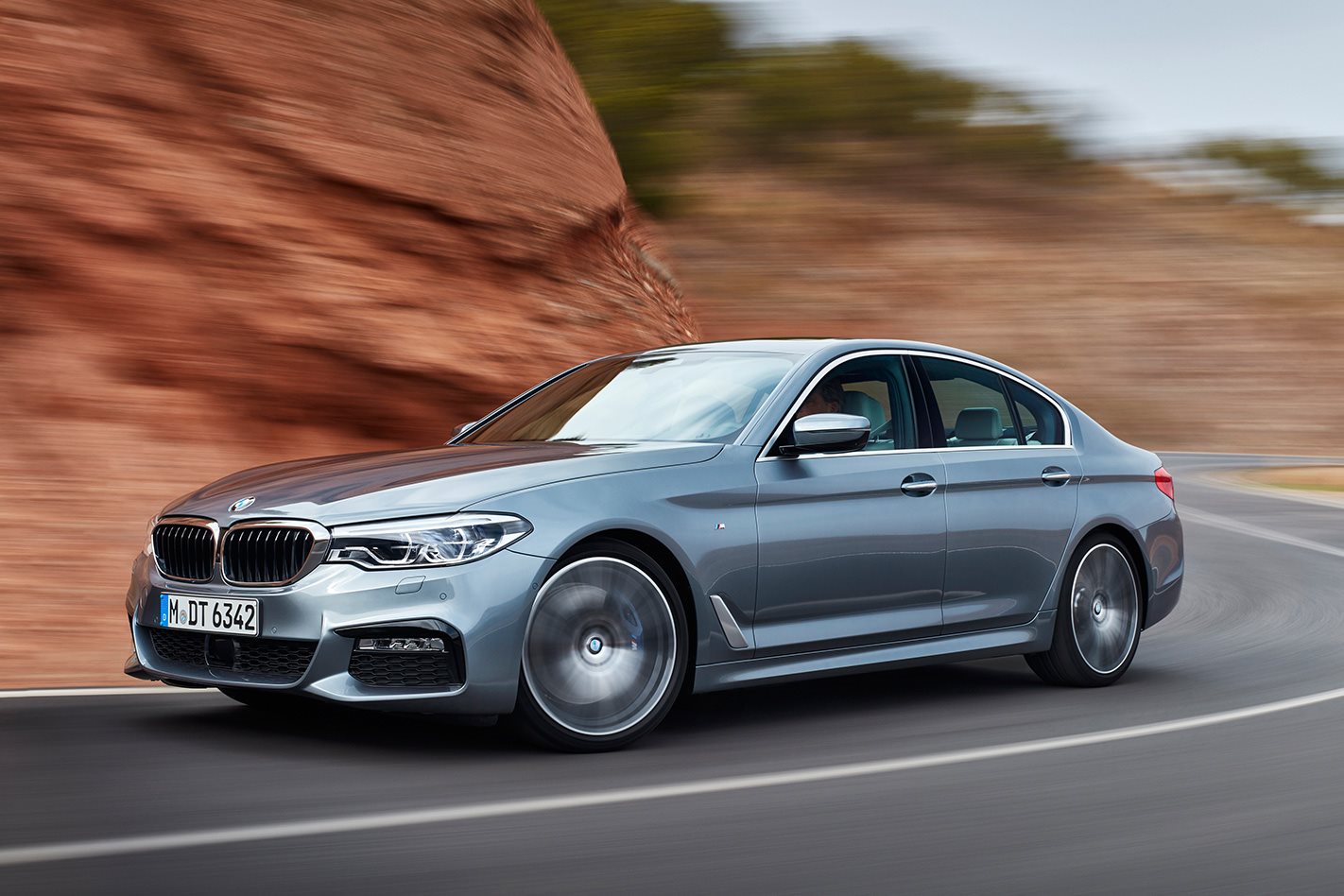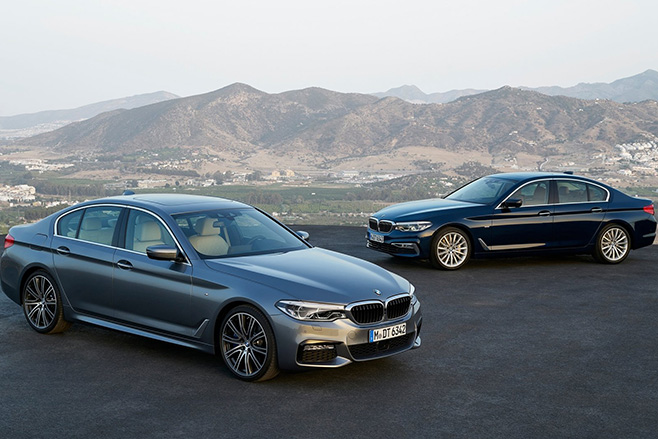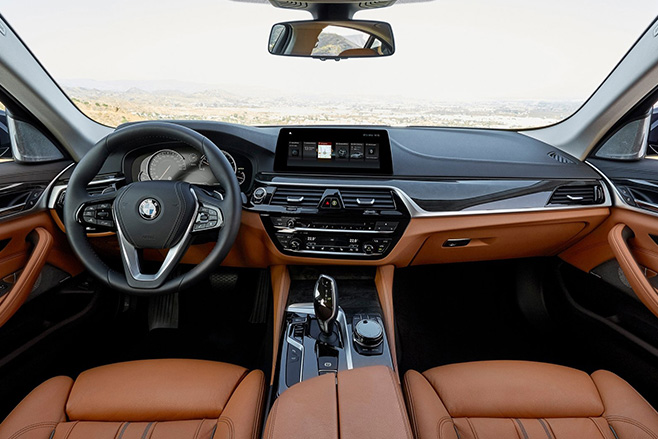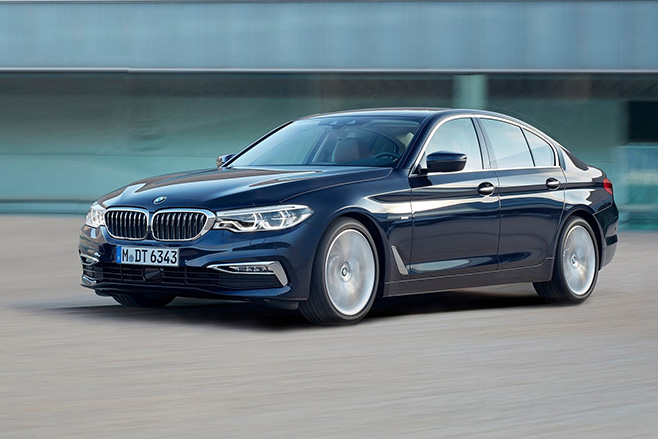
BMW hasn’t gone far for design inspiration for the seventh-generation of its 5 Series sedan, which has a strong resemblance to the current generation along with design cues from the larger BMW 7-Series.
Exterior changes look more like a facelift than all-new model, albeit with sharper looks including a pronounced shoulder line, full-width headlights and a slightly narrower kidney grille. The boot is more integrated into the redesigned C-pillar, which looks more streamlined, helping reduce the drag co-efficient by 10 percent.
The wheelbase has been extended by 7mm to 2975mm, with track width increased by a few millimetres across the range. Despite the bigger footprint, it’s up to 100kg lighter than the current model thanks to the EfficientLightweight design concept that utilises more aluminium and high-strength steels than before.
There’s also plenty of change under the bonnet with enhanced performance throughout the revamped range, which includes an AMG rivalling V8 performance model and new turbocharged petrol diesel options in place of the 528i and 535i/d.

All come with an eight-speed Steptronic transmission, apart from the 520d which comes with manual as standard.
The range will be released in two stages, with the new standard petrol and diesel models part of the global launch on February 11. These include:
- The new entry-level 530i. It’s powered by a 2.0-litre four-cylinder engine which generates 185kW/350Nm and can accelerate from 0-100km/h in 6.2secs and averages combined fuel consumption figures of 5.4L/100km.
- The new 540i, with a 3.0-litre inline six, produces 250kW/450Nm that’s capable of 0-100km/h in 5.1secs and a nippy 4.8secs in xDrive guise. Average fuel consumption stands at 6.5L/100km.
- The new 530d, which supersedes the 535d with a smaller inline six-cylinder turbo diesel that generates 195kW/620Nm. While its 5.7sec run from 0-100km/h is just 0.2secs slower than 535d, fuel consumption is considerably reduced from 6.1L/100kms to 4.5L/100kms.
- The 520d, which is one of the remaining variants, is still powered by a 2.0-litre four-cylinder diesel engine producing 140kW/400Nm and mated to either a six-speed manual or eight-speed Steptronic transmission, but has a reduced combined fuel consumption of around 4.0L/100kms depending on transmission.

The rest of the range will be released on March 2017 and includes a mix of highly economical models and the above mentioned hot saloon. These include:
- The BMW 530e iPerformance. It’s a plug-in hybrid with a 185kW/420Nm 2.0-litre four-cylinder petrol engine plus BMW eDrive electric drive system and an electric range of 45km. Combined fuel consumption is just 2.0L/100km.
- The BMW 520d EfficientDynamics Edition, which is powered by a 140kW/400Nm 2.0-litre four-cylinder diesel engine that goes about its business with a combined fuel consumption of 3.9L/100km.
- The new BMW M550i xDrive, with a less thrifty twin turbocharged 4.4-litre V8 petrol engine, generates 340kW/650Nm at 5,500 rpm. It can accelerate from 0-100km/h in a flat four seconds. That’s 0.4 secs quicker than the current M5.

Optional active cruise control comes with extended functions including optional Intelligent Speed Assist which is capable of relieving the driver of acceleration, braking and steering duties from standing start up to 210km/h.
Another cool option is Remote Control Parking, which lets you park from outside to help you squeeze into tight spaces.
The head-up display is 70 percent larger with sharper resolution and all versions will come with BMW’s Professional Media system as standard, featuring a 10.25-inch display with touch control and the latest i-Drive set-up.
Apps include Car-to-X, which allows your car to communicate with other BMWs, sharing traffic and weather information.
Other interior upgrades include a new instrument cluster, acoustic glazing for the windscreen and an optional Bowers & Wilkins sound system.
BMW is yet to release Australian specifications and pricing.




